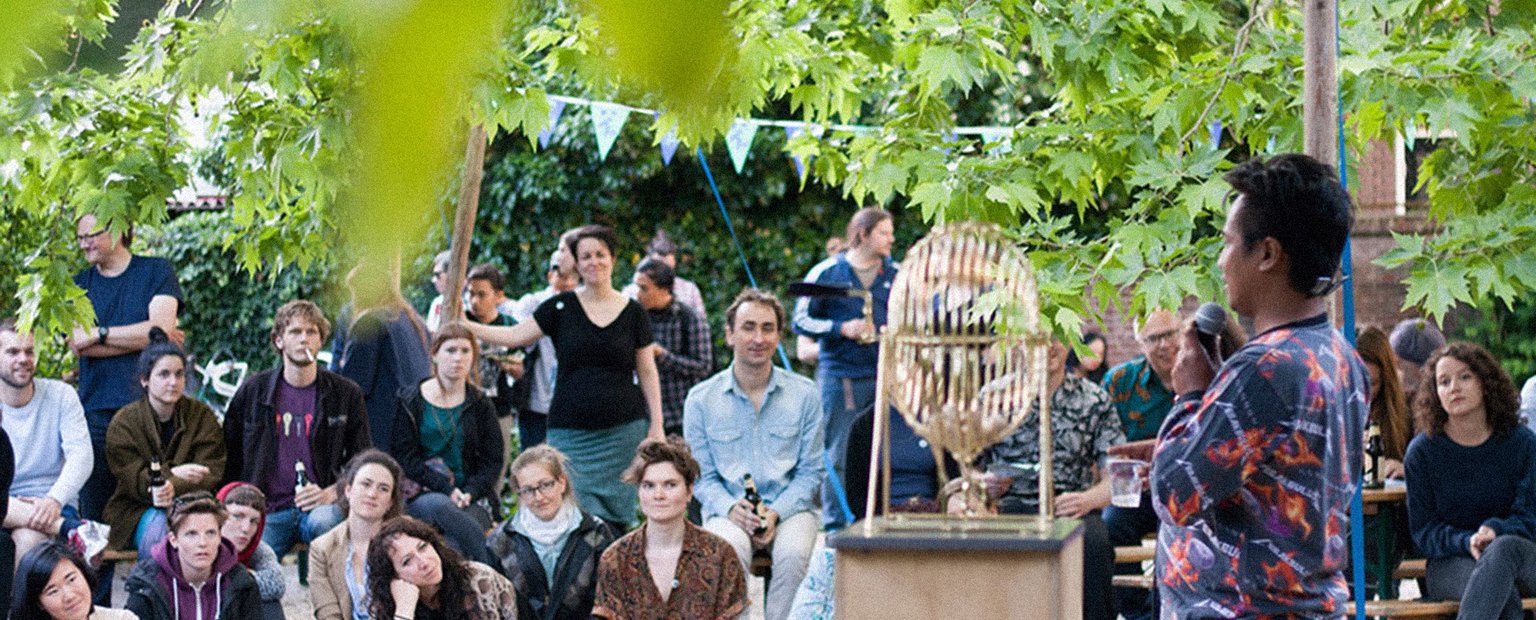On the 9th of june 2016 artist Wok The Rok organised in collaboration with the Casco-team Parasite Lottery.
Parasite Lottery, inspired by arisan, is a pilot collective lottery system for art organisations in the Netherlands and their communities. For Nuraini Juliastuti, Parasite Lottery was an inspiration to research more elaborately on arisan.
More about Parasite lottery can be found here.

Parasite Lottery Lucky Draw #1 (June 2015), Photo by Carlijn Bakker - Casco
Arisan: a transitional economic system
Jan Newberry defines arisan as a monthly credit lottery and describes how it works as follows: “At each meeting, members contribute a fixed amount, and each in turn receives the entire collected amount during the course of the arisan’s run (several weeks, months, or as long as it takes). Although identified here as a credit lottery, the arisan is just as easily described as a savings association.” The members of arisan refer to it as a way of saving—a forced one. There are other definitions, however.
Edward Miguel, Paul Gertler, and David I. Levine discuss arisan as an Indonesian typical self-help group that built on the foundation of social networking, saving mechanism, and loans provision. Kempe Ronald Hope defines it as a group saving association in which temporary loans are possible. Bala Shanmugam refers to it as a rotating credit association. Both Hope and Shanmugam respectively emphasize arisan as part of the subterranean and informal economy. They provide many examples to show the existance of arisan-like mechanisms in different contexts—tontines and Kootu (Malaysia), paluwagan (the Philippines), adashi or cha in Nigeria, ROSCA or rotating saving credit association (South Africa), chita (India), sou-sou (Trinidad and Tobago), tanda (Mexico), and gameya (Egypt).
The emphasis on informality indicates the function of arisan as a transitional economic system. For those who are not familiar with the cold and bureaucratic banking system, the familiarity of arisan is a feature to make it easier to partake in organizing personal finance. Arisan is the intermediary, “the middle rung”, says Geertz, from a traditionalistic agrarian society to a commercialistic one.
More economic
According to Geertz, arisan has become “more and more specifically economic rather than diffusely social institutions.” It has become the norm to be part of two, three, or even more arisan groups. The reason is to be able to save more. On the one hand, it indicates willingness to save. On the other, however, the savings might be distributed for different expenses and needs, and dissolved as soon as they are obtained. To illustrate this, I use my mother’s story as an example. She is a member of four arisan groups. As much as my mother enjoys going to arisan, there were many occasions where she could not attend due to her work obligations. Despite being busy, she did not want to miss a single arisan meeting, and at once lose the possibility of narik. A common strategy that is applied to deal with this problem is to get a representative whom is tasked with paying the contribution money. A simple solution is to get a wakil, or representative – for example, a daughter or close relative. My mother often asked my older sister to represent her.
The social meaning of arisan, often unsettled by the busy and hectic lives of its members, has the potential to be reproduced and revitalized in some ways. The difficulty in getting a representative is because arisan requires high social skills; a skill not everyone is at ease with. Especially if this includes chit-chat with a group of much older women. The challenge is to convince the prospective representative that going to arisan can be an OK experience too. After regularly being present at my mother’s arisan groups, my sister eventually had the idea of joining the groups herself. Rather than going to arisan as a mere representative, she made the most of it by subscribing to its meaning—a powerful economic institution.
Another aspect to reveal from the fear of losing the opportunity to get the arisan fund is an attempt to learn to commit to the basic principle of the arisan, as Shanmugam writes, “the duty-bound to make regular contributions.” The failure to provide the commitment would result in shame and distrust among the group. Because it suggests the lack of “discipline to set aside money regularly.” This is an aspect, which has brought Geertz to conclude arisan as an “educational mechanism.” The educational value lies in its capacity “to change their whole value framework from one emphasizing particularistic, diffuse, affective, and ascriptive ties between individuals, to one emphasizing—within economic contexts—universalistic, affectively neutral, and achieved ties between them.”
Communal harmony
Kerukunan, communal harmony, manifested in the gathering, has been the key element in the operationalization of arisan (see Geertz). Geertz alludes to the word ‘arisan’ as mutual help. My assumption is that it derives from Javanese, the language spoken by the people in Mojokuto, Geertz’s main research area. But ‘arisan’ sounds like ‘warisan’, an Indonesian word, which literally means an inheritance. It derives from ‘waris’, a Javanese word that is absorbed by Indonesian, which means an inheritor. The collected lump sum of the arisan, succeeded to one member to the other, indeed feels like a collective inheritance.
The gathering aspect aside, based on my childhood memories, arisan is an opportunity to share good food and eat together. The host of the arisan meeting always provides special food, the kind of food and drinks that might not be available on a daily basis. Eating together is an added element that makes arisan pleasurable. Going to an arisan is a much-awaited event, because it is like going out to eat, which does not occur often. For the same reason, I liked it when my mother asked me to come to an arisan with her. Though I always ended up doing my own things there—sitting quietly next to my mother, reading.
To organize an arisan is like organizing a feast. It is a time-consuming process, which involves complicated preparation. The whole house has to be clean and tidy (in fact, the host needs to perform well too—wearing a proper outfit is a must). Beautiful plates, bowls, mugs, and jars are curated and displayed out on the table as part of the food display. The guests will praise the delicious food provided. They will extend particular attention to the spatiality of the arisan—the house of the host (the neatness of the living room, what paintings, photos, and other things are displayed on the walls, or the cleanliness of the toilet). The host will go about arisan preparation as best she can in order to avoid being the subject of gossip. Gossip, ngobrol-ngobrol, and other types of casual conversations are essential parts of the meeting. The members express enthusiasm for arisan by coming early (so that there will be ample time for chit-chatting and gossiping).
Arisan is a powerful performative tool. It is an open platform that can be appropriated for showing the current state of possession to others within a familiar environment.
The hosts have to use their personal money to prepare the food. Some feel burdened with this aspect, since it seems contrary to the spirit of arisan as a saving mechanism. While the social aspect of arisan is highly valued, it entails performing a series of careful calculations. It would be careless to spend large parts of the saving just for food. Some arisans ask their members to contribute an extra amount of money to be allocated to create a collective saving pot. The collective saving pot can be used for different purposes—funding for the food preparation included.
For practical and economic reasons, some hosts choose to provide takeaway snacks in boxes instead. It removes the risk of losing the lavish element that is commonly expected from arisan food. Nonetheless it does not seem to reduce the excitement that emerges from getting free food. When I did not join my mother to an arisan, I would wait for her at home in anticipation of receiving a small box of snacks.
Frictions
As a savings association based on mutual help principle, the operationalization scope of arisan is limited to small groups in which the members know each other. Researches on arisan confirm the condition that it would not occur in a group where the members are unfamiliar to each other. The meaning of mutual help is restricted and not inclusive. What criteria is there for someone to be considered and invited as an arisan member? Inclusion and exclusion are two factors to govern the existence of arisan. It points to the limit of the common aspect of a community-based alternative financial group.
According to Erik Bähre, when writing about ROSCA in a South African township, ‘helping each other’, in many contexts, is often not compatible with ‘taking care of oneself’–“ ‘helping each other’ is centered on sharing, while ‘taking care of oneself’ valued accumulation.” The politics of everyday life is composed of countless moments where one has to make, again Bähre, “precarious choices” concerning when to help the others and to take care of personal safety. When helping each other and taking care of oneself collides, it results in frictions and episodes of what Bähre coined as “reluctant solidarity”.
Precariousness
Difficult times often come unexpectedly. It causes precarious feelings. Not everyone has an advantage of being in a position where the availability of resources is abundant, or having a wealthy network to hold on. And nothing can be more dreadful than having debt bondage. The fear for debt is strong. Credit and debt have a long history in Southeast Asia. They informed social structures in many levels. It tells about the power of the creditor and the limitation of the debtor. Arisan emerges as a support institution that derives from the familial realm. At once it is a mechanism with the certainty that each person would be able to support his or her own needs.
Arisan is often considered a typical ibu-ibu, or woman’s practice. Plenty of research suggests it is not a gendered practice. To locate arisan in the everyday domain of women provides space to examine the use of arisan and imagination of precariousness within the inter-relational framework of the wife, the husband, and the family. Hanna Papanek and Laurel Schwede read arisan as part of a woman’s strategy to help deal with economic stress of the family. Further, they see it as part of the conscious decision of a woman to actively engage in earning and managing in the family. It signifies a degree of independency. The husband, the children, or other members of the family usually do not put serious attention to arisan. Such attitude stems from a perspective of the practice as woman’s practice. It has made arisan a special locus to lend freedom in managing the fund obtained.
A woman and mother, in Papanek and Schwede’s research, found many reasons to participate in arisan and to think about how to make and save more money for her family. Throughout time women have been affected by different kinds of uncertainty—the inflation of the 1950s and 1960s, the Japanese occupation, the fear of hunger, the fight for independence from the Dutch—experiences, which shaped childhood and disrupted schooling. Each woman might have different reason, which encourages her to join an arisan. My mother always thinks about her desires for having enough money for my sisters’ family and myself. The purpose of the money does not need to be specific. What is important is there is enough money to be used when the needs call. My older sister always thinks about money to fund the education needs of her children.
Keep going
There have been attempts at modifying the structure of arisan. In a recent conversation with a friend, I was told that she participated in an arisan, in which three persons would get the money in one 'pull' (narik). It reduces the amount of money received, since the lump sum fund needs to be divided into three. At least, it is certain that fresh cash will be at hand on a scheduled time. There are many factors to ignite precariousness. Hence the feeling seems to be persistent. This is a factor to maintain the relevancy of arisan. Arisan is a known practice emerged as cultural reference to approach uncertainty. It is an attempt to come to grips with difficult situation. It shows the will to find something to hold on, and to endure.
Newberry, Jan. 2007. “Rituals of Rule in the Administered Community: The Javanese Selametan Reconsidered.” Modern Asian Studies 41, no.6: 1295-1329.
Miguel, Edward, Paul Gertler, and David I. Levine. 2006. “Does Industrialization Build or Destroy Social Networks?” Economic Development and Cultural Change 54, no.2: 287-317.
Hope, Kempe Ronald Sr. 1993. “Growth and Impact of the Subterranean Economy in the Third World.” Futures October: 864-876.
Shanmugam, Bala. 1991. “Socio-Economic Development Through the Informal Credit Market.” Modern Asian Studies 25, no.2: 209-225.
Geertz, Clifford. 1962. “The Rotating Credit Association: A Middle Rung in Development.” Economic Development and Cultural Change 10, no.3: 241-263.
Shanmugam, Bala. 1991. “Socio-Economic Development Through the Informal Credit Market.” Modern Asian Studies 25, no.2: 219.
Geertz, Clifford. 1962. “The Rotating Credit Association: A Middle Rung in Development.” Economic Development and Cultural Change 10, no.3: 247.
Shanmugam, Bala. 1991. “Socio-Economic Development Through the Informal Credit Market.” Modern Asian Studies 25, no.2: 219
Geertz, Clifford. 1962. “The Rotating Credit Association: A Middle Rung in Development.” Economic Development and Cultural Change 10, no.3: 260.
Geertz, Clifford. 1962. “The Rotating Credit Association: A Middle Rung in Development.” Economic Development and Cultural Change 10, no.3: 243.
Bähre, Erik. 2007. Money and Violence: Financial Self-Help Groups in a South African Township. 90. Leiden & Boston: Brill.
Bähre, Erik. 2007. Money and Violence: Financial Self-Help Groups in a South African Township. 99. Leiden & Boston: Brill.
Henley, David. 2009. “Credit and Debt in Indonesian History: An Introduction”, in Henley and Boomgaard (eds.), Credit and Debt in Indonesia, 860 – 1930: From Peonage to Pawnshop, From Kongsi to Cooperative, 1-40.
Papanek, Hanna., and Laurel Schwede. 1988. “Women are Good with Money: Earning and Managing in an Indonesian City.” Economic and Political Weekly 23, no.44: WS-73-WS-84.
Papanek, Hanna., and Laurel Schwede. 1988. “Women are Good with Money: Earning and Managing in an Indonesian City.” Economic and Political Weekly 23, no.44: WS-77.
This article was published in the (Un)usual Business journal Utrecht Meent Het #2 (September, 2016).

